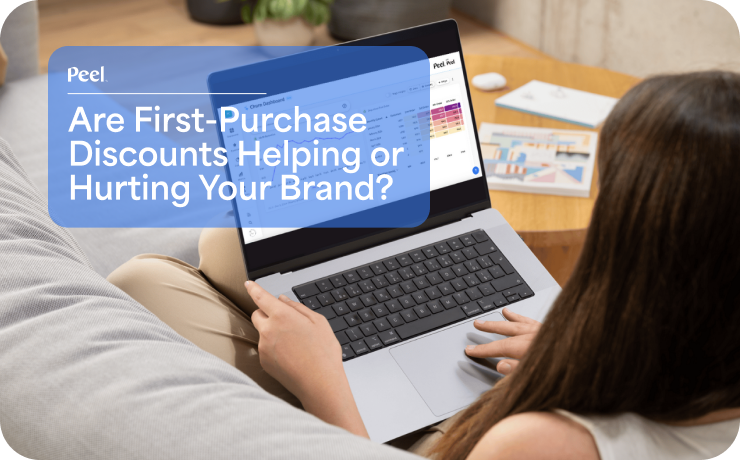The Business Intelligence space is huge, and we know choosing an analytics solution is not easy - not to mention, time-consuming.
Whether you are starting to evaluate a new data solution or already have a favorite platform, here are answers to the 5 top frequently asked questions about Peel.
1. How is Peel different from other BI tools like Looker and Tableau?
Peel is built for founders, marketers and product managers at small and midsize businesses who don’t have the resources (technical expertise & cost) to set up and maintain business intelligence solutions. Small businesses can’t afford business intelligence solutions, and midsize businesses rebuild the same solution and don't have monitoring - but they all want to understand strategic business analysis about customer purchasing behavior.
Peel manages all the data, connects, compiles and processes datasources, analyzes reports and calls out trends. It’s a full service tool, that supports the end user in strategic decision making, but managing, processing, and analyzing the data.
Unlike Tableau, Mode or Looker which are visualization tools for analysts to use, Peel automates data and reporting, and analyzes over 35 metrics across hundreds of segments (locations, stores, products, cohorts, attribution sources, tags, etc.) All of this is automated for businesses through daily trend reports, plus access to prebuilt reporting in a web view. Everything is precomputed, analyzed, and visualized ready for businesses to explore without having to do the setup, maintenance and analysis!
Peel is offering an “out-of-the-box” solution to make data analysis, strategic decision making, and data consumption affordable, accessible, and available!
2. How is Peel different from marketing analytics platforms like Google Analytics?
Founders, marketers and product managers at ecommerce businesses use Peel’s automated monthly cohort analysis to answer questions like,
- What happened to the customer’s who first bought in November?
- Was the acquisition campaigned that we spent on in June helpful in capturing loyal repeat purchasers?
- What cohort has our most valuable customers?
- What is the total lifetime revenue of each monthly cohort?
- Did we acquire more customers?
- Did we change prices?
- What was the product that encouraged up-selling and cross-selling behaviors?
- Is there a specific cohort of customers who bought a product that has a better retention or repurchase rate or is it a specific discount code or location?
Knowing the Customer Acquisition Cost across ad networks from different attribution windows, campaigns, and attribution sources helps teams align on where their dollars are being used appropriately, without having to manually calculate CAC themselves on a bunch of interchangeable decisions that Peel automatically processes for them. It is imperative that teams know their return on marketing dollars and can explain the subtleties of what's driving the growth campaigns and what has worked.
3. How long does it take to implement Peel?
Time to value! Fast. All you have to do is CLICK, add the App from the Shopify store and wait patiently (a few hours to a few days - depending on how big and old your business is.) Think about how much data you have captured from every order over the years - Peel downloads all of that since it is a part of your revenue, profitability and customer cohort story.
4. Is Peel secure?
Security Practices
Peel applications are hosted on Amazon Web Service Fargate which meets the standards for PCI DSS Level 1, ISO 9001, ISO 27001, ISO 27017, ISO 27018, SOC 1, SOC 2, SOC 3, and HIPAA eligibility. We store customer account data in encrypted Amazon RDS databases and have an additional encryption layer for your data source credentials not to allow our staff to have access to them. Additionally, thanks to Fargate, our application servers are not accessible to anyone on our team. Our website and servers use HTTPS over SSL (TLS 1.3) to protect your data.
Database access and data storage
Peel accesses your database directly from our application servers using TLS encryption when available, and stores all data in private Amazon S3 buckets monitored by Amazon Security. Only our applications are granted access to the data on S3 when updating or reading and analyzing them. All files are deleted within 60 days or sooner automatically. By design, Peel will never ask you for Personally identifiable information (PII) about your users or customers not to ever download or store it.
Shopify connection
Similar to databases access, Peel only ever accesses Shopify orders for analytics personal data is never retrieved. We store all data in private Amazon S3 buckets monitored by Amazon Security. The data from your account is only ever used for analyses on your account.
We know how critical the stability of our clients’ stores is and we do not request “write” access never to influence the content of the stores in any way.
Sign-in with Slack
Peel uses Sign-in with Slack. Slack interfaces with SSO providers, handles two-factor authentication, and confirms email addresses but will not share your password with Peel. Peel will store your Slack User identifier, your username on Slack and your email address; they will all be updated each time you login to Peel.
Slack notification
Peel uses Slack’s standard “incoming webhook” to send messages to the one channel you or your teammates specified during setup. We find that this is the least intrusive access level and it does not grant Peel the ability to read messages on your Slack workspace.
Want to learn more about using Peel to analyze your data? Start a free trial here.







.webp)



.avif)



.png)


.svg)
.svg)